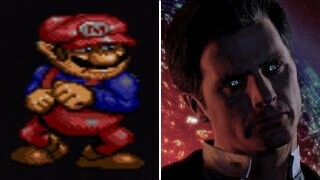5 Video Game Urban Legends That Shouldn't Have Fooled Anyone

Just like the mass adoption of high-definition camera phones has significantly decreased the number of bigfoot sightings, so have the detail-focused ultra video game hackers of today greatly diminished the proliferation of creepy video game facts that turned out to be bunk. That's a shame, as video game urban legends are the basis for many of the Internet's coolest and spookiest collective memories.
We can totally get Mew in the original Pokémon
The Urban Legend:
Don't Miss
Moltros, Articuno, Zapdos, and Mewtwo, the rarest known Pokémon from the original Red and Blue versions of the game all inhabited their own cool-ass dungeons, but Mew, the rarest and most elusive Pokémon of all somehow lived under a van. Source: older kids at every single school in the world.

Nintendo
The Truth:
Though Mew really was inside the cartridge, we could only get it via official Nintendo events (or through breaking the game).
GTA: San Andreas hides the bigfoot
The Urban Legend:
The Bigfoot is real and he lives in San Andreas. The irrefutable proof is a bunch of early youtube videos that are as blurry as the classic real-life bigfoot photos. Maybe, as the great Mitch Hedberg once said, bigfoot really is blurry, a naturally out-of-focus monster roaming the countryside.
IT'S CLEAR AS DAY, SHEEPLE!
The Truth:
San Andreas is indeed home to a lot of fun and even scary easter eggs, such as cars driven by ghosts, but there's no such thing as a bigfoot living in its woods. The people of Rockstar took notice, though, and ended up including a Sasquatch in Red Dead Redemption's Undead Nightmare DLC.
Sonic was in the original Super Smash Bros.
The Urban Legend: The Super Smash Brothers series ended up becoming the greatest crossover event in the history of gaming, but it had small beginnings in a relatively self-contained title for the Nintendo 64. Still, many-a-fan claimed that Sonic, Nintendo's sworn enemy, was somehow in the game, waiting to be unlocked.
The Truth: He wasn't, otherwise data miners would have extracted him by now. Hell, they extracted the Master Hand, the most powerful entity in that world, and turned it into a playable character. Players were looking the wrong way. Sonic was never in a Nintendo game, or at least not during the great Nintendo-Sega war of the ‘80s and ’90s. What a bummer. To make up for it, we can reveal that it was actually Mario who was totally hidden inside a Sega Saturn game as a very shady-looking captive.
The game in question is, uh, Astal.

Sega
We got the name right, right? Well, this is what it looks like.

Sega
Anyway, data miners recently found this guy in the deepest pipes of its game code.

Sega, Nintendo
Mass Effect 3 Has A Good story, actually
The Urban Legend:
Nobody liked the ending of Mass Effect 3 because it mostly dismissed everything the two previous games in the series had been building up to, so a surprisingly large subset of fans desperately posited the theory that there was a different and better story underneath that most of us just weren't seeing. See, our character was being mind controlled by the bad aliens throughout the entire third game in the trilogy, and therefore the bad things weren't just the result of poor writing, but rather of really good writing!

BioWare
The Truth:
The only indoctrinated were the people who believed that there was some good subtext in the story of Mass Effect 3. Tolerate it or hate it, the ending that post-EA acquisition BioWare wanted us to see is the one we got. Trying to fool ourselves into believing that there's a grand plan behind that storyline is a questionable idea with a capitol capital Q.
It's not much, but anyone looking for some closure can just look at this interview from 2022 where Drew Kapshyn, the series' main writer who left before Mass Effect 3 talks about endings he had in mind for the series.
Pokémon Lavender Town Syndrome Had Kids Committing Suicide
The Urban Legend:
Oh, yeah, this is when things get really creepy. Pokémon Red and Green caused a bunch of Japanese children to commit suicide. The urban legend states that this was caused by the music from Lavender Town which contained high frequencies that could only be heard by kids. The origin? Some say the game's director is an evil man who wanted to hurt kids, some others say it was a Japanese government psyop, but it was actually just some bullcrap invented by 4chan.

Nintendo
The Truth:
Correlation doesn't equal causation, so even though suicides among children really did rise during that time, they had nothing to do with Pokémon. Pokémon's Green, Blue (what westerners got instead of Green) and Red versions were no more dangerous than any other game of the time, meaning that they were merely very dangerous. The Lavender Town Syndrome is bullcrap; the Havana Syndrome, however, the more recent and very syndrome that affected a bunch of American diplomats after a stay at a hotel in Cuba.... is also total bunk. Worry not, though, as the Pokémon world is still filled with really weird secrets.
Top Image: BioWare